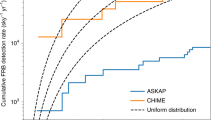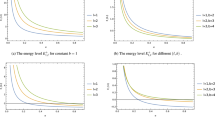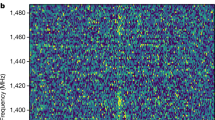Abstract
Cosmic strings are now established as a possible mechanism for forming galaxies and clusters in the Universe (refs 1–4; H. Sato, preprint HUNS 827, Kyoto University, 1986). Much recent work has been devoted to calculating the behaviour of strings and their interaction with matter in an effort to understand better the special features of the string model. Here, I examine two effects which have been neglected in many treatments but which could, it appears, alter certain details of our picture of string-induced galaxy formation. First, loops of cosmic string behave like relativistic gyroscopes, and undergo only a very slow precession under the influence of newtonian gravitational torques. They thus impose a 'stiff time-averaged quadrupolar gravitational potential on matter in their vicinity. Second, the gravitational radiation beamed by an oscillating loop probably has a significant component of dipole asymmetry when averaged over the loop decay time. Recoil reaction on the loop causes a coherent acceleration over time and eventually leads to a high peculiar velocity when loops decay. String loops today would then not generally be found in the centres of galaxies and clusters, but flying freely through intergalactic space.
This is a preview of subscription content, access via your institution
Access options
Subscribe to this journal
Receive 51 print issues and online access
$199.00 per year
only $3.90 per issue
Buy this article
- Purchase on Springer Link
- Instant access to full article PDF
Prices may be subject to local taxes which are calculated during checkout
Similar content being viewed by others
References
Vilenkin, A. Phys. Rep. 121, 263–315 (1985); Vilenkin, A. in Inner Space/Outer Space (eds Kolb, E. W. et al.) 269 (University of Chicago Press, 1986).
Turok, N. Phys. Rev. Lett. 55, 1801 (1985).
Turok, N. & Brandenberger, R. H. Phys. Rev. D33, 2175 (1986).
Hogan, C. J. & Rees, M. J. Nature 311, 109 (1984).
Kibble, T. W. B. & Turok, N. Phys. Lett. 116B, 141 (1982).
Turok, N. Nucl. Phys. B242, 520 (1984).
Vachaspati, T. & Vilenkin, A. Phys. Rev. D31, 3052 (1985).
Silk, J. & Vilenkin, A. Phys. Rev. Lett. 53, 1700 (1984).
Hogan, C. J. Phys. Lett. 143B, 87 (1984).
Vilenkin, A. & Field, G. Nature (in the press).
Author information
Authors and Affiliations
Rights and permissions
About this article
Cite this article
Hogan, C. Runaway cosmic strings. Nature 326, 853–855 (1987). https://doi.org/10.1038/326853a0
Received:
Accepted:
Published:
Issue Date:
DOI: https://doi.org/10.1038/326853a0
This article is cited by
-
SQUID behavior at liquid nitrogen temperature in high-T c superconductors of the type Y-Ba-Cu-O
Journal of Low Temperature Physics (1988)
Comments
By submitting a comment you agree to abide by our Terms and Community Guidelines. If you find something abusive or that does not comply with our terms or guidelines please flag it as inappropriate.



